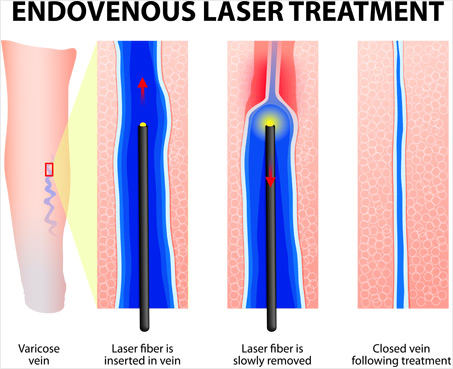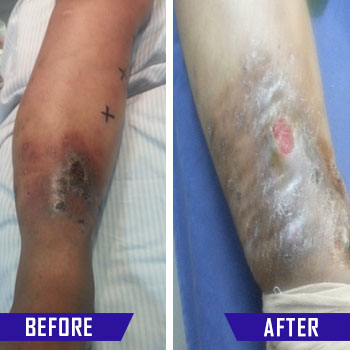

INTRODUCTION : VARICOSE VEINS are swollen veins which often look blue, bulging and twisted. Veins of legs and ankles are most commonly affected by this condition. If left untreated, varicose vein can worsen over time.
LASER treatment EVLA (Endovenous Laser Ablation) for the management of Varicose Veins is available at KARAN HOSPITAL. It is a most recent surgical technique for the treatment of Varicose Veins.
Varicose veins may not cause any pain. Signs you may have with varicose veins include:
• Veins that are dark purple or blue in color
• Veins that appear twisted and bulging; often like cords on your legs When painful signs and symptoms occur, they may include:
• An achy or heavy feeling in your legs
• Burning, throbbing, muscle cramping and swelling in your lower legs • Worsened pain after sitting or standing for a long time
• Itching around one or more of your veins
• Bleeding from varicose veins
• A painful cord in the vein with red discoloration of the skin
• Color changes, hardening of the vein, inflammation of the skin or skin ulcers near your ankle, which can mean you have a serious form of vascular disease that requires medical attention Spider veins are similar to varicose veins, but they're smaller. Spider veins are found closer to the skin's surface and are often red or blue. They occur on the legs, but can also be found on the face. Spider veins vary in size and often look like a spider's web.
Arteries carry blood from your heart to the rest of your tissues. Veins return blood from the rest of your body to your heart, so the blood can be recirculated. To return blood to your heart, the veins in your legs must work against gravity. Muscle contractions in your lower legs act as pumps, and elastic vein walls help blood return to your heart. Tiny valves in your veins open as blood flows toward your heart then close to stop blood from flowing backward. Causes of varicose veins include:
• Age. As you get older, your veins can lose elasticity, causing them to stretch. The valves in your veins may become weak, allowing blood that should be moving toward your heart to flow backward. Blood pools in your veins, and your veins enlarge and become varicose. The veins appear blue because they contain deoxygenated blood, which is in the process of being recirculated through the lungs.
• Pregnancy. Some pregnant women develop varicose veins. Pregnancy increases the volume of blood in your body, but decreases the flow of blood from your legs to your pelvis. This circulatory change is designed to support the growing fetus, but it can produce an unfortunate side effect — enlarged veins in your legs. Varicose veins may surface for the first time or may worsen during late pregnancy, when your uterus exerts greater pressure on the veins in your legs. Changes in your hormones during pregnancy also may play a role. Varicose veins that develop during pregnancy generally improve without medical treatment three to 12 months after delivery.
Risk factors
These factors increase your risk of developing varicose veins:
• Family history. If other family members had varicose veins, there's a greater chance you will too.
• Obesity. Being overweight puts added pressure on your veins.
• Standing or sitting for long periods of time. Your blood doesn't flow as well if you're in the same position for long periods.
Complications
Complications of varicose veins, although rare, can include:
• Ulcers. Extremely painful ulcers may form on the skin near varicose veins, particularly near the ankles. Ulcers are caused by long-term fluid buildup in these tissues, caused by increased pressure of blood within affected veins. A discolored spot on the skin usually begins before an ulcer forms. See your doctor immediately if you suspect you've developed an ulcer.
• Blood clots. Occasionally, veins deep within the legs become enlarged. In such cases, the affected leg may swell considerably. Any sudden leg swelling warrants urgent medical attention because it may indicate a blood clot — a condition known medically as thrombophlebitis.
• Bleeding. Occasionally, veins very close to the skin may burst. This usually causes only minor bleeding. But, any bleeding warrants medical attention because there's a high risk it can happen again.
Fortunately, treatment usually doesn't mean a hospital stay or a long, uncomfortable recovery. Thanks to less invasive procedures, varicose veins can generally be treated on an outpatient basis. Ask your doctor if insurance will cover any of the cost of your treatment. If done for purely cosmetic reasons, you'll likely have to pay for the treatment of varicose veins yourself. Self-care — such as exercising, losing weight, not wearing tight clothes, elevating your legs, and avoiding long periods of standing or sitting — can ease pain and prevent varicose veins from getting worse. Compression stockings - Wearing compression stockings all day is often the first approach to try before moving on to other treatments. They steadily squeeze your legs, helping veins and leg muscles move blood more efficiently. The amount of compression varies by type and brand. You can buy compression stockings at most pharmacies and medical supply stores. Prices vary. Prescription-strength stockings also are available. Additional treatments for more-severe varicose veins If you don't respond to self-care or compression stockings, or if your condition is more severe, your doctor may suggest one of these varicose vein treatments:
• Sclerotherapy. In this procedure, your doctor injects small- and medium-sized varicose veins with a solution that scars and closes those veins. In a few weeks, treated varicose veins should fade. Although the same vein may need to be injected more than once, sclerotherapy is effective if done correctly. Sclerotherapy doesn't require anesthesia and can be done in your doctor's office.
• Foam sclerotherapy of large veins. Injection of a large vein with a foam solution is also a possible treatment to close a vein and seal it. This is a newer technique.
• Laser surgeries. Doctors are using new technology in laser treatments to close off smaller varicose veins and spider veins. Laser surgery works by sending strong bursts of light onto the vein, which makes the vein slowly fade and disappear. No incisions or needles are used.
• Catheter-assisted procedures using radiofrequency or laser energy. In one of these treatments, your doctor inserts a thin tube (catheter) into an enlarged vein and heats the tip of the catheter using either radiofrequency or laser energy( EVLT). As the catheter is pulled out, the heat destroys the vein by causing it to collapse and seal shut. This procedure is the preferred treatment for larger varicose veins.
• High ligation and vein stripping. This procedure involves tying off a vein before it joins a deep vein and removing the vein through small incisions. This is an outpatient procedure for most people. Removing the vein won't adversely affect circulation in your leg because veins deeper in the leg take care of the larger volumes of blood.
• Ambulatory phlebectomy : Your doctor removes smaller varicose veins through a series of tiny skin punctures. Only the parts of your leg that are being pricked are numbed in this outpatient procedure. Scarring is generally minimal.
• Endoscopic vein surgery. You might need this operation only in an advanced case involving leg ulcers if other techniques fail. Your surgeon uses a thin video camera inserted in your leg to visualize and close varicose veins and then removes the veins through small incisions. This procedure is performed on an outpatient basis. Varicose veins that develop during pregnancy generally improve without medical treatment within three to 12 months after delivery.
A unique and complete solution for the treatment of venous incompetence . . .
• Greater saphenous vein
• Small saphenous vein
• Perforating veins
• Recurrences
• Venous Ulcer
• Preferentially absorbed by intracellular water of the vein wall and the water content of blood
• Approx. 40 times higher absorption coefficient in water compared to 980nm lasers
• Approx. 400 times higher absorption coefficient in water compared to 810nm lasers
• A laser fiber is being introduced into the vein using a special catheter set
• The vein is being coagulated from inside by laser energy
APPLICATIONS :
• Great Saphenous Veins
• Branch Varies
• Reticular Varices
• Recurrences
• Ulceration
• Access to the Vein
• Anesthesia by local intradermal injection
• Entry of the needle into the vein
• After the puncture the guide wire is inserted into the vein
• The entry needle is withdrawn and the introducer sheath and dilator are inserted over the guide wire and into the vein
• The guide wire is then removed and the laser fiber is inserted into the introducer sheath and advanced along its length
• The introduction of the laser fiber can be monitored by using the aiming beam
• The fibre is advanced to a position 2-3 centimeters below the sapheno-femoral junction to preserve the integrity of the femoral vein from the first pulse of laser energy
• The final position 2-3 cm below the sapheno femoral junction is controlled by ultrasound/ marker under C Arm.
• Mark the run of the vein by small circles
• Local anesthesia with a Chlor-ethyl cooling spray
• Injection with a small needle
• Lasering 3x with 6W, pulse length of 0.5 -1s and break of 1s
• Every 1-2 cm of the vein set 3 laser pulses
• The vein disappears directly
• Treatment duration 5-10 min
• No discoloration of skin, as sometimes happened during transcutaneuos lasering or sclerotherapy
• Also for patients getting anticoagulation drugs
• No skin burning
• Free of pain
• Patients are satisfied
• Can be performed in every practice
• A good method also for all dermatologists



